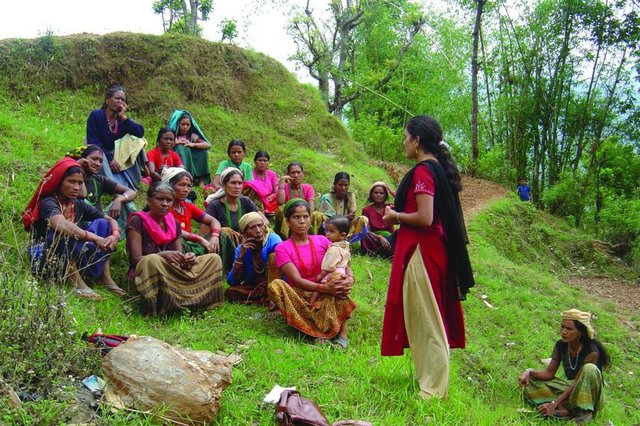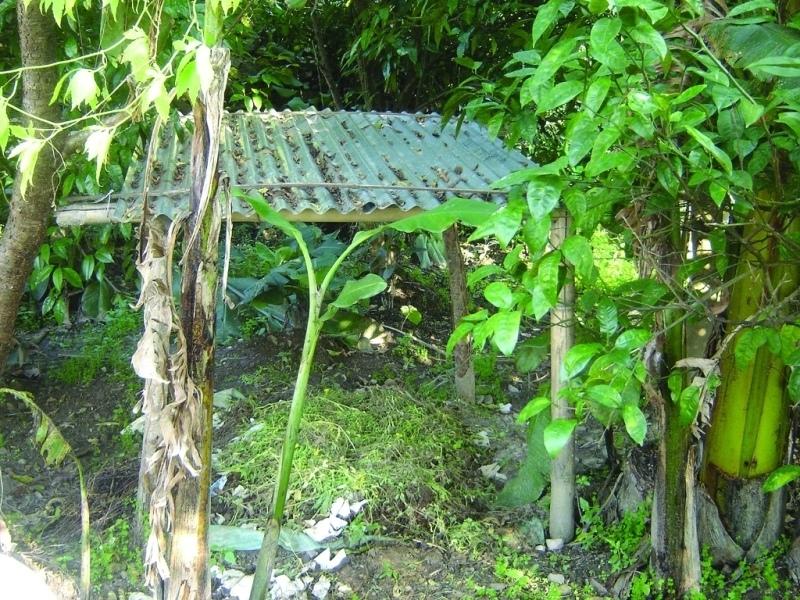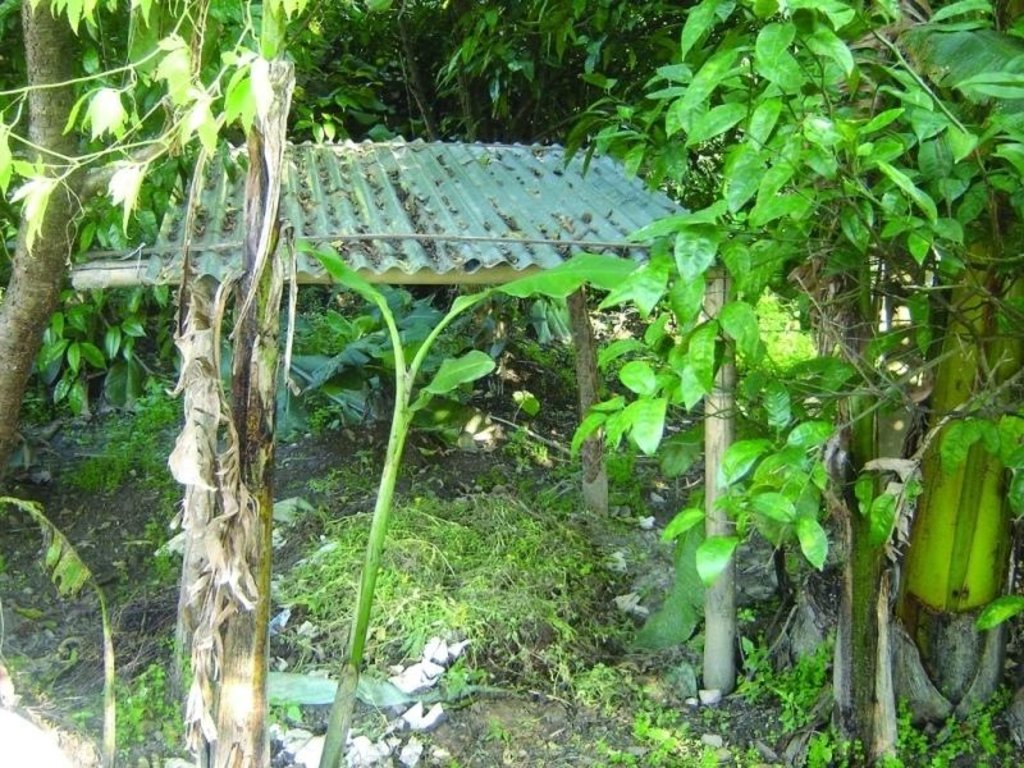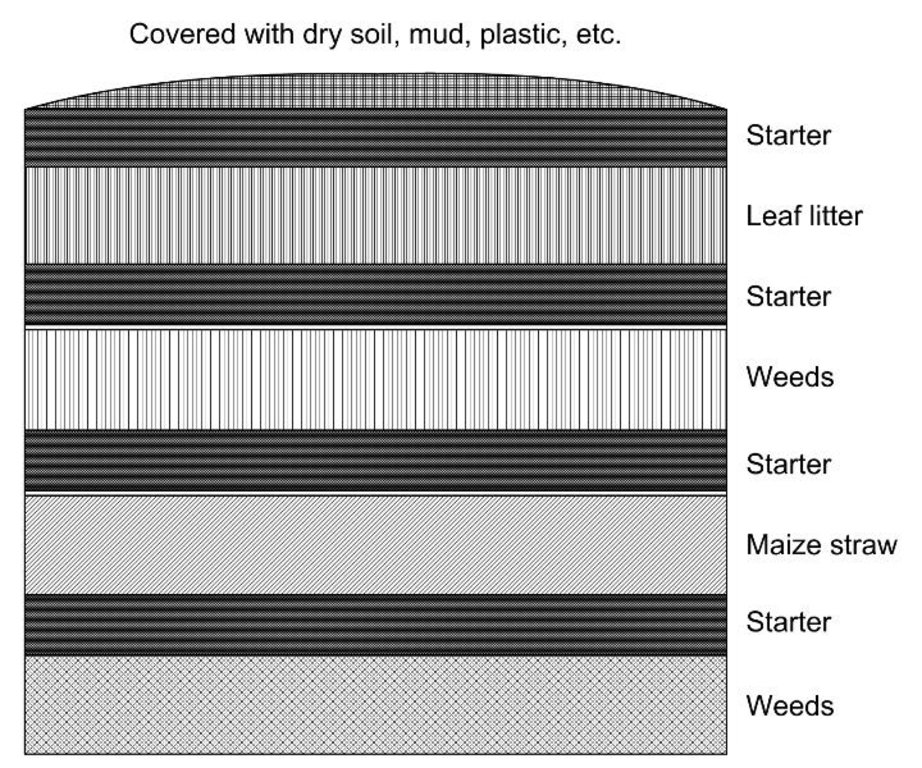Improved compost preparation [Непал]
- Создание:
- Обновить:
- Составитель: Richard Allen
- Редактор: –
- Рецензент: David Streiff
Sudhariyeko compostmal nirman (Nepali)
technologies_1750 - Непал
Просмотреть разделы
Развернуть все Свернуть все1. Общая информация
1.2 Контактные данные специалистов и организаций, участвующих в описании и оценке Технологии
Специалист по УЗП:
Director
+977 1 5520314
Soil Management Directorate, Department of Agriculture
Непал
Специалист по УЗП:
Team Leader
+977 1 5543591
ssmp@helvetas.org.np
Sustainable Soil Management Programme
GPO Box 688, Kathmandu/Nepal
Непал
Название проекта, содействовавшего документированию/оценке Технологии (если применимо)
Sustainable Soil Management Programme, Nepal (SSMP)Название организации (-ий), содействовавших документированию/оценке Технологии (если применимо)
Department of Agriculture, Soil Management Directorate, Hariharbhawan Lalitpur (doasoil) - НепалНазвание организации (-ий), содействовавших документированию/оценке Технологии (если применимо)
HELVETAS (Swiss Intercooperation)1.3 Условия, регламентирующие использование данных, собранных ВОКАТ
Когда были собраны данные (на местах)?
06/11/2008
Составитель и ответственный(-ые) специалист(-ы) согласны с условиями, регламентирующими использование собранных ВОКАТ данных:
Да
1.5 Ссылка на Анкету (-ы) по Подходам УЗП

Farmer field schools on integrated plant nutrient systems [Непал]
Participatory and collaborative learning through the farmer field school approach
- Составитель: Richard Allen

Farmer-led experimentation [Непал]
Participatory technology testing and adaptation through farmer-led experiments
- Составитель: Richard Allen

Farmer-to-farmer diffusion [Непал]
Wider diffusion of sustainable soil management technologies through a demand responsive farmer-to-farmer diffusion approach
- Составитель: Richard Allen
2. Описание Технологии УЗП
2.1 Краткое описание Технологии
Определение Технологии:
Improved compost preparation using a range of biomass and waste to produce high value fertiliser
2.2 Подробное описание Технологии
Описание:
Compost can be prepared from a wide range of organic materials including dead plant material such as crop residues, weeds, forest litter, and kitchen waste. Compost making is an efficient way of converting all kinds of biomass into high value fertiliser that serves as a good alternative to farmyard manure, especially for crop-growing households without livestock. The compost is often mixed with forest soil, ripe
compost from the previous batch, or even a small amount of animal dung as a starter for the decomposition process. The mix of materials determines the quality of the final compost as much as the management of the composting process. Nitrogen-rich fresh materials such as legume residues and many types of weeds and shrubs are mixed with carbon-rich forest litter and cereal residues. Small amounts of wood ash, lime, or mineral fertiliser can help increase or balance the overall nutrient content of the compost.
The compost needs to be turned every 30-50 days depending on the mix and the outside temperature. It should be protected from direct sunlight, rainfall and runoff so as to reduce volatilisation and leaching of nutrients. The material must remain moist at all times to avoid slowing down decomposition and hindering the efficiency of the micro and macro-organisms involved in decomposition. Heaping the compost or collecting the material in a pit helps the compost to reach the temperatures needed (700C) to destroy pests and weeds.
Once the compost is well decomposed and has an earthy smell, it can be applied directly or stored for later application. It can be applied as a crop fertiliser in rows or to individual plants for improving general soil fertility and organic matter content, thus improving the soil structure and its water holding capacity.
2.3 Фотографии, иллюстрирующие Технологию
2.5 Страна/ регион/ места, где применяется Технология, информация о которых собрана в данной Анкете
Страна:
Непал
Более точная привязка места:
Midhills districts of Nepal
Map
×3. Классификация Технологии УЗП
3.1 Основные цели и задачи реализации Технологии
- Improve compost production
3.2 Текущий(-ие) тип(-ы) землепользования на территории, где применяется Технология

Пахотные угодья и плантации
- Однолетние культуры
Пояснения:
Major land use problems (compiler’s opinion): Intensifying cultivation practices with either 1) the inadequate application of fertilisers leading to a decline in soil
fertility and the mining of soil nutrients or 2) the application of too much fertiliser causing environmental problems
through excessive leaching, and losses of fertiliser in surface runoff and consequent eutrophication or nitrification of
streams, ponds or groundwater.
3.4 Категория УЗП, к которой относится Технология
- Комплексное управление почвенным плодородием
- Управление отходами/ сточными водами
3.6 Мероприятия УЗП, выполняемые в рамках Технологии

управленческие мероприятия
- У7: Другие
3.7 Основные проблемы деградации земель, на решение которых направлена Технология

ухудшение химических свойств почв
- Хп: Снижение плодородия и уменьшение содержания органического вещества (вызванное не эрозией, а другими причинами)
3.8 Предотвращение и снижение деградации земель, или восстановление нарушенных земель
Укажите цель Технологии по отношению к деградации земель :
- снижение деградации земель
4. Технические характеристики, мероприятия по практической реализации, вложения и стоимость
4.1 Технический рисунок, иллюстрирующий Технологию
4.2 Спецификация / пояснения к техническому рисунку
Layering of the different materials in
a compost pit
Note: This is just an example and
need not be followed exactly. The
important aspects are:
- the need for a starter such as
forest soil or manure
- place weeds in the centre of
the pit so that they are fully
decomposed
- cover dry materials with moist
material and material that only
decays slowly with easily
decaying material.
The pit can be 1 to 2m in diameter
and about 1m deep.
The size depends on the available
biomass for composting and the
amount of compost required.
Technical knowledge required for field staff / advisors: low
Technical knowledge required for land users: low
Main technical functions: increase in soil fertility and productivity, increase in soil organic matter content, improvement in physicalsoil conditions, increase in soil water holding capacity
4.3 Общая информация по необходимым вложениям и стоимости
Укажите денежные единицы, использованные для подсчета затрат:
- Доллары США
Укажите среднюю дневную заработную плату наемных работников:
2.00
4.4 Мероприятия, необходимые для начала реализации
| Деятельность | Тип мероприятия | Сроки | |
|---|---|---|---|
| 1. | Dig a 1-2m diameter and 1m deep pit using a spade or shovel | Управленческие | |
| 2. | Collect crop residues, grass, tree leaves, ash, lime, and animal urine | Управленческие | |
| 3. | Put a layer of ash at the bottom of the pit followed by tree leaves, grass, crop residues, and a layer of forest soil (as it contains the necessary microorganisms – bacteria, fungi, etc. – and quickens the decomposition process) | Управленческие | |
| 4. | Add more tree leaves, crop residues, and grass until the pit is full and contains a healthy mixture of dry and fresh/moist materials | Управленческие | |
| 5. | Cover the compost heap with a fi ne layer of ash or mud and a cap of | Управленческие |
4.5 Вложения и затраты, необходимые для начала реализации
| Опишите затраты | Единица | Количество | Затраты на единицу | Общая стоимость на единицу | % затрат, оплаченных землепользователями | |
|---|---|---|---|---|---|---|
| Оплата труда | Preparing compost pit | Persons/day | 2,0 | 2,0 | 4,0 | 100,0 |
| Общая стоимость запуска Технологии | 4,0 | |||||
4.6 Поддержание/ текущее обслуживание
| Деятельность | Тип мероприятия | Сроки/ повторяемость проведения | |
|---|---|---|---|
| 1. | Dispose of domestic and household wastewater and cattle urine in the pit to keep it moist (but not saturated/soaked) until it is fully decomposed. | Управленческие | |
| 2. | The compost needs to be turned every 30-50 days depending on the mix and the outside temperature. | Управленческие | |
| 3. | Depending on the location, it takes about 3-6 months for the compost to be fully decomposed. | Управленческие |
4.7 Стоимость поддержания/ текущего обслуживания ( в год)
| Опишите затраты | Единица | Количество | Затраты на единицу | Общая стоимость на единицу | % затрат, оплаченных землепользователями | |
|---|---|---|---|---|---|---|
| Оплата труда | Maintaining compost | Persons/day | 1,0 | 2,0 | 2,0 | 100,0 |
| Общая стоимость поддержания Технологии | 2,0 | |||||
Пояснения:
Cost as in January 2007
5. Природные и социально-экономические условия
5.1 Климат
Среднегодовое количество осадков
- < 250 мм
- 251-500 мм
- 501-750 мм
- 751-1000 мм
- 1001-1500 мм
- 1501-2000 мм
- 2001-3000 мм
- 3001-4000 мм
- > 4000 мм
Пояснения/ комментарии по осадкам:
Annual rainfall: Also 2000-3000 mm
Агроклиматическая зона
- влажная
Thermal climate class: subtropics
5.2 Рельеф
Склоны (преобладающие):
- пологие (0-2%)
- покатые (3-5%)
- покато-крутые (6-10%)
- крутые (11-15%)
- очень крутые (16-30%)
- чрезвычайно крутые (31-60%)
- обрывистые (>60%)
Формы рельефа:
- плато/ равнины
- гребни хребтов/холмов
- склоны гор
- склоны холмов
- подножья
- днища долин
Зона высотной поясности:
- 0-100 м над уровнем моря
- 101-500 м н.у.м.
- 501-1000 м н.у.м.
- 1001-1500 м н.у.м.
- 1501-2000 м н.у.м.
- 2001-2500 м н.у.м.
- 2501-3000 м н.у.м.
- 3001-4000 м н.у.м.
- > 4 тыс. м н.у.м.
Комментарии и дополнительные сведения по условиям рельефа/ топографии :
Slopes on average: Also moderate (6-10%), rolling (11-15%) and hilly (16-30%)
Landforms: Also footslopes
Altitudinal zone: Also 1000-1500 m a.s.l., 1500-2000 m a.s.l. and 2000-2500 m a.s.l.
5.6 Характеристика землепользователей, применяющих Технологию
Рыночная ориентация производства:
- натуральное хозяйство (самообеспечение)
- товарное/ рыночное хозяйство
Индивидуальное или коллективное хозяйство:
- частное/ домовладение
Укажите другие важные характеристики землепользователей:
Off-farm income specification: In most farm households, off-farm income plays at least a minor and increasingly a major role. Occasional opportunities for off-farm income present themselves in the form of daily labour wages. Some households’ members receive regular salaries, whilst an increasing number of Nepalis are working in India, the Middle East, Malaysia, and elsewhere and sending remittance incomes home.
5.7 Средний размер земельных участков, арендуемых или находящихся в собственности землепользователей, применяющих Технологию
- < 0,5 га
- 0,5-1 га
- 1-2 га
- 2-5 га
- 5-15 га
- 15-50 га
- 50-100 га
- 100-500 га
- 500-1000 га
- 1000-10000 га
- > 10000 га
5.8 Собственность на землю, права на земле- и водопользование
Землевладелец:
- индивидуальная, не оформленная в собственность
- индивидуальная, оформленная в собственность
Право землепользования:
- аренда
- индивидуальное
Пояснения:
Sharecropping between owner and tenant
6. Воздействия и заключительные положения
6.1 Влияние Технологии УЗП в пределах территории ее применения
Социально-экономическое воздействие
Доходы и затраты
сельскохозяйственные издержки
Комментарий/ пояснения:
Reduced expenses on chemical fertilisers
объем работ
Комментарий/ пояснения:
Preparation of compost is labour intensive
Экологическое воздействие
Другие экологические последствия
Soil fertility
Organic crop production
Application of fertilizer
6.2 Влияние Технологии за пределами территории ее применения
загрязнение подземных/ речных вод
Комментарий/ пояснения:
Reduction of nutrient influx into water bodies
Dependence on external inputs
6.4 Анализ эффективности затрат
Насколько получаемый результат сопоставим с первоначальными вложениями (с точки зрения землепользователей)?
Эффективность затрат в краткосрочной перспективе:
позитивное
Эффективность затрат в долгосрочной перспективе:
позитивное
Насколько получаемый результат сопоставим с текущими расходами по поддержанию технологии (с точки зрения землепользователей)?
Эффективность затрат в краткосрочной перспективе:
позитивное
Эффективность затрат в долгосрочной перспективе:
позитивное
Пояснения:
The high cost of mineral fertilisers means that the establishment costs are soon recovered. In the long-term, a major reduction in costs leads to large benefits.
6.5 Внедрение Технологии
Пояснения:
Comments on spontaneous adoption: About 30% of the participants of SSMP activities related to compost making, and about 20% of farmers that were
not part of the programme have adopted the technology.
6.7 Сильные стороны/ преимущества/ возможности Технологии
| Сильные стороны/ преимущества/ возможности по мнению составителя или других ключевых специалистов |
|---|
|
The use of compost reduced the need for mineral fertiliser thus reducing production costs and outside dependence How can they be sustained / enhanced? Further promote the technology to increase this impact |
|
Compost making does not require any livestock How can they be sustained / enhanced? Its low cost and use of local materials makes it the fertiliser of choice for poor households |
| In-situ composting saves labour involved in transporting compost to the fields |
6.8 Слабые стороны/ недостатки/ риски Технологии и пути их преодоления
| Слабые стороны/ недостатки/ риски по мнению составителя или ответственных специалистов | Возможные пути их преодоления/снижения? |
|---|---|
| The preparation of compost is not appropriate for commercial use (except in nurseries) | Compost improvement should go hand-in-hand with promoting alternatives for the other requirements |
| Compost requires a large amount of biomass which may otherwise be needed for fuel, fodder, or animal bedding |
7. Справочные материалы и ссылки
7.2 Ссылки на опубликованные материалы
Название, автор, год публикации, ISBN:
STSS; SSMP (2001) Farmyard Manure and Compost Management (in Nepali). Kathmandu: Soil Testing Services Section, Department of Agriculture andSustainable Soil Management Programme
Где опубликовано? Стоимость?
SSMP
Ссылки и модули
Развернуть все Свернуть всеСсылки

Farmer field schools on integrated plant nutrient systems [Непал]
Participatory and collaborative learning through the farmer field school approach
- Составитель: Richard Allen

Farmer-led experimentation [Непал]
Participatory technology testing and adaptation through farmer-led experiments
- Составитель: Richard Allen

Farmer-to-farmer diffusion [Непал]
Wider diffusion of sustainable soil management technologies through a demand responsive farmer-to-farmer diffusion approach
- Составитель: Richard Allen
Модули
Нет модулей





